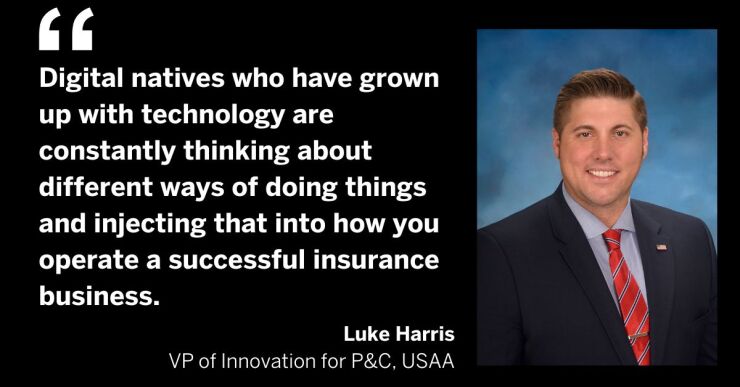USAA, Aflac, AXA XL on carriers' maturing insurtech strategy

With economic conditions driving changes in the insurtech startup ecosystem, Digital Insurance is taking stock of what was accomplished in the last several years of big funding and big ideas. This item presents the carrier-side view; for the view from the startup side, click here.
Insurance carriers seeing the progress of technology in the industry since 2016 adopt that technology in a mix of in-house ventures, partnerships and acquisitions. Executives at some major carriers spoke to Digital Insurance about what they see as the latest advances, including data handling, and what pressures can dictate their insurtech operations decisions.
Insurers should remember that innovation does not automatically mean technology, says Rose Hall, head of innovation for the Americas at AXA XL. Insurance was ripe for innovation, and offered a lot of opportunity for start-ups, she explains. Now, years into the process, insurers have a mature model for what kinds of companies they want to work with and seek technologies that can transform their business at scale.
“The startup market is going to fluctuate based on how much money is flowing into the funding. Most startups are venture-capital funded, not bootstrapped,” Hall says. “Venture capital was pouring in the last two years and they were just investing in anything and everything.
Now it’s starting to pull back a little bit, which is crunching some technologies. It’s good and bad. It’s good because it weeds some out, but it’s bad because it weeds out what otherwise might be a great technology but just can’t get more traction.”
Thats why insurtech startup activity receding from peaks in 2016 and 2020 doesn’t necessarily mean innovation and technology activity is waning, according to Shelia Anderson, CIO of Aflac.
“Economic uncertainty absolutely doesn’t mean that we stop innovating. I think it gives us the exact opposite impetus,” she says. “That’s a time where we should be really focusing and we are focusing on advancing our transformation inside of our companies to help us navigate the current environment, and position us for success in the future.”
Insurers are seeing more emphasis on getting new technologies in place quickly, according to Alec Miloslavsky, founder and CEO of EIS, a cloud-hosted digital insurance platform. “The stress on time to market has both an offensive and defensive nature. Offensively, we see both traditional but also non-traditional players that are going into adjacent markets,” he says. “Defensively, carriers, especially in various incarnations of personal lines, are looking at grabbing a larger share of the wallet in order to keep customers doing business.”
Still, carriers have to be pushed to innovate, in Miloslavsky’s view. “They’re a notoriously conservative bunch, especially in area that could be so rife with risks,” he says . “They will be sitting on the sidelines waiting for somebody to blaze the trail and the push will come from the vendor side, in my view.”
Carriers who have a legacy environment need to build new platforms for insurance products one at a time, says Brian Poppe, senior vice president of income and wealth planning at Mutual of Omaha, which is currently undergoing this transition. “You can’t migrate everything wholesale. You don’t want to add to the legacy problem,” he said. “It’s hard not to do that without a new platform, without a place to go.”
Being on the cutting edge of technology for insurance means considering data not just for its own sake, but in a problem-solving context, according to Hall of AXA XL. “First, they’re looking to solve a problem. Then the data can help them optimize that solution,” she says . “But the data is secondary. The data analytics is secondary to the problem.”
Some insurers think insurtechs and incubators should look carefully at data. Insurance is “an industry that’s rich in data,” Anderson said. “We have a tremendous knowledge of our customer base. Usually there’s a long history that you retain and from a customer perspective, your customer data. That’s an environment that’s rich in opportunity to provide better service and leverage these types of capabilities.”
Aflac, similarly, watches the startup incubator space, according to Anderson. “Innovation ecosystems outside of your four walls is key to look at,” she explains. “We engage and look at the startup community. All that’s going to help us to expand our capacity to deliver – leveraging those partnerships.”
Strategies at USAA
USAA built a lot of its newer digital capabilities in-house, but does sometimes turn to outside insurtech providers, as it did in 2021 when it acquired Noblr for its UBI capabilities. Like AXA XL and New York Life, USAA has a venture capital arm to support new technology startups.
“What we’ve seen across the industry over the past six years or so, is definitely a heightened interest in how emerging technologies can benefit the end-to-end insurance lifecycle,” says Luke Harris, vice president of innovation for P&C at USAA. “We’re looking at alternative distribution models for how we sell insurance across the industry. We’re looking at leveraging automation on those low complexity tasks that may be able to be self service and not require a traditional phone call.”
USAA considers whether buying technology, building it or making an alliance is the best approach to particular operational functions, according to Harris. “That could be developing a product or capability internally,” he says. “That could be identifying someone who may be considered best in breed and who matches our vision, our mission and our core values.”
USAA has innovation teams that seek to understand new technologies and how they work with business objectives, Harris explains. They assess the technologies’ viability and the business case, asking what success would look like for those innovations, including adoption, change management and scaling up usage.
“Our innovation is focus on the long-term vision,” Harris says. “We make that early investment in understanding the change components, the technology implications, what it would mean to our business and ultimately how it impacts our members. Before we start that work or engage in a partnership, we already have a really good idea of how this is going to be successful and the pathway to getting it there.”

Harris sees the insurance market following this approach, being receptive to what technologists develop. “Digital natives who have grown up with technology are constantly thinking about different ways of doing things and injecting that into how you operate a successful insurance business,” he says. “The market has started to kind of realize that as well. That’s why you’re seeing that little bit of migration of more traditional insurance people into that insurtech environment, but you’re also still seeing a lot of technologists who are very excited about the opportunities around this industry.”
Along with its innovation team, USAA watches and works with insurtech incubators. “Often we will share problems or business opportunities to solve,” Harris says. “It’s amazing the type of ideas or concepts that are coming from entrepreneurs, veteran entrepreneurs, that are things that we may not have thought of, but that help us further accelerate our vision.”



